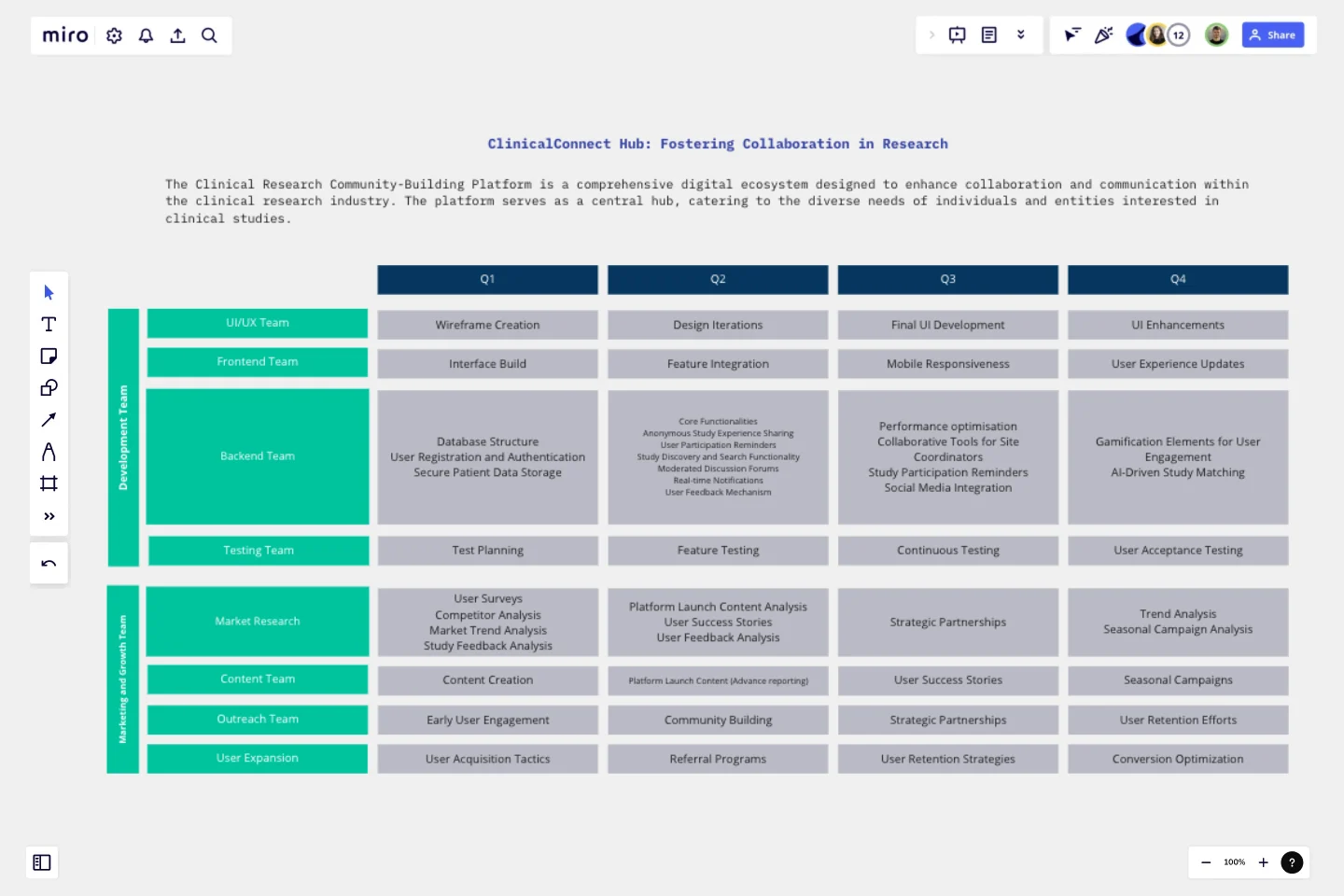Product Roadmap by Sahithi Alluru
This roadmap lays out the key steps and plans for different teams, such as design, development, testing, and marketing, for the quarters (Q1, Q2, Q3, Q4).
It helps us coordinate efforts, ensuring everyone works together towards the same goal. The roadmap includes essential features like user registration, secure data storage, and study discovery in must-have categories. It also outlines other features such as user feedback mechanisms and mobile responsiveness. This roadmap benefits our entire team, from developers to marketers, and helps us stay focused on creating a successful platform step by step.
Instructions to use the board
This board is designed to provide insights into the key stages of user engagement and business growth using the AARRR framework: Acquisition, Activation, Retention, Revenue, and Referral. Below are the instructions to navigate and utilize the board effectively:
Acquisition:
Explore the "Acquisition" section to understand marketing strategies and initiatives to increase brand visibility.
Look for conversion metrics related to platform visits and user registrations.
Activation:
Navigate to the "Activation" section to discover advertising and PR efforts leading to user sign-ups.
Examine conversion metrics focusing on the percentage of first-time users.
Retention:
Move to the "Retention" section to understand user communication strategies and encourage long-term engagement.
Evaluate the conversion metric for maintaining a high percentage of active users.
Revenue:
Examine the "Revenue" section to understand sales strategies and subscription-based revenue models.
Review conversion metrics associated with the monetary value of each subscription.
Referral:
Visit the "Referral" section to explore referral programs and initiatives driving user recommendations.
Analyze conversion metrics related to friends invited through referrals.
This template was created by Sahithi Alluru.
Get started with this template right now.
The Product Storyboard
Works best for:
Product Management, Planning
The Product Storyboard template enables product managers to visualize product experiences and user journeys. By mapping out key touchpoints, interactions, and scenarios, this template helps teams understand user needs and pain points. With sections for defining user personas, storyboarding user flows, and capturing feedback, it supports iterative product design and validation. This template serves as a storytelling tool for communicating product visions and guiding product development efforts towards delivering exceptional user experiences.
Cone Roadmap
Works best for:
Roadmap, Planning, Mapping
The Cone Roadmap template offers a visual representation of project timelines and dependencies, with a focus on narrowing scope over time. By starting with broad initiatives and gradually refining them into actionable tasks, teams can manage complexity and ensure alignment with strategic goals. This template promotes transparency and adaptability, empowering teams to respond effectively to changing priorities and market dynamics.
Product Ops Canvas
Works best for:
Product Management, Planning
The Product Ops Canvas template helps product managers align product strategies with operational capabilities. By mapping out key operational processes, tools, and metrics, this template fosters alignment between product and operational teams. With sections for identifying bottlenecks and optimizing workflows, it supports continuous improvement in product operations. This template serves as a guide for driving efficiency and scalability in product management processes, enabling teams to deliver high-quality products at scale.
Product Vision Statement
Works best for:
Product Management, Planning
The Product Vision Statement template helps product teams articulate clear and inspiring visions for product development. By defining long-term goals, market aspirations, and customer value propositions, this template aligns teams around a shared vision for success. With sections for outlining strategic objectives, guiding principles, and success metrics, it provides clarity and direction for product development efforts. This template serves as a compass for product teams, guiding them towards meaningful outcomes and driving innovation and growth.
Logic Model by Natalie Poindexter
Works best for:
Roadmap, Planning
The Logic Model is a comprehensive planning and evaluation tool that serves as a roadmap for project implementation and assessment. It visually represents the connections between project activities, outputs, and intended outcomes.
Empathy Map Template
Works best for:
Market Research, User Experience, Mapping
Attracting new users, compelling them to try your product, and turning them into loyal customers—it all starts with understanding them. An empathy map is a tool that leads to that understanding, by giving you space to articulate everything you know about your customers, including their needs, expectations, and decision-making drivers. That way you’ll be able to challenge your assumptions and identify the gaps in your knowledge. Our template lets you easily create an empathy map divided into four key squares—what your customers Say, Think, Do, and Feel.
